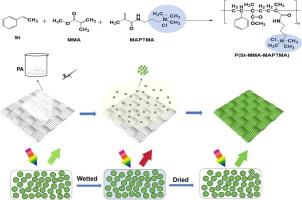Colorimetric textile sensors based on the photonic crystals structural color with fast water responsiveness and antibacterial properties
IF 6.3
2区 化学
Q1 POLYMER SCIENCE
引用次数: 0
Abstract
Textiles-based wearable sensors with colorimetric sensing can transform external stimuli to visible color changes, which are ideal for the development of low-cost wearable sensors. Among them, textile-based water-response structural color colorimetric sensors have received wide attention for their pollution-free and eco-friendly characteristics. In this research, poly (styryl-methyl methacrylate-[3-(methylacrylamide) propyl] trimethyl ammonium chloride) (P(St/MMA/MAPTMA)) microspheres with hydrophilic quaternary ammonium salt groups were prepared, which were atomized and deposited on textile fabrics anticipating to prepare textile-based water response colorimetric sensors. P(St/MMA/MAPTMA) microspheres with different particle diameters were obtained by adjusting the mass ratios of the monomers, which were assembled on the fabrics to form different structural colors. These structural colors showed fast water response property to change color when they were wetted by water within 2 s. The P(St/MMA/MAPTMA) microspheres structural colors on the fabrics can return to their original structural colors after drying showing the reversible water responsiveness, which have the promising application prospect of water-response colorimetric sensors. Moreover, the antibacterial rates of these structural colors on fabrics were greater than 98 % showing excellent antibacterial properties. This research shows that this textile-based water-response structural color colorimetric sensors exhibit potential application prospects in the field of water content monitoring, such as the diapers for monitoring the amount of baby’s urine, or the clothing for monitoring the amount of human sweat.

基于光子晶体结构色的织物比色传感器,具有快速的水响应性和抗菌性能
基于纺织品的可穿戴传感器具有比色传感功能,可以将外界刺激转化为可见的颜色变化,是开发低成本可穿戴传感器的理想选择。其中,基于纺织品的水响应结构色比色传感器因其无污染、环保的特点而受到广泛关注。本研究制备了具有亲水性季铵盐基团的聚(苯乙烯-甲基丙烯酸甲酯-[3-(甲基丙烯酰胺)丙基]三甲基氯化铵)(P(St/MMA/MAPTMA))微球,并将其雾化沉积在纺织织物上,以期制备基于纺织品的水响应比色传感器。通过调整单体的质量比,得到不同粒径的P(St/MMA/MAPTMA)微球,并将其组装在织物上,形成不同的结构颜色。这些结构色具有快速的水响应特性,被水浸湿后在2 s内变色。织物上的P(St/MMA/MAPTMA)微球结构色在干燥后可以恢复到原来的结构色,表现出可逆的水响应性,在水响应比色传感器中具有很好的应用前景。结构色对织物的抑菌率均大于98%,具有良好的抗菌性能。本研究表明,这种基于纺织品的水响应结构色比传感器在含水量监测领域具有潜在的应用前景,例如用于监测婴儿尿量的纸尿裤,或用于监测人体出汗量的服装。
本文章由计算机程序翻译,如有差异,请以英文原文为准。
求助全文
约1分钟内获得全文
求助全文
来源期刊

European Polymer Journal
化学-高分子科学
CiteScore
9.90
自引率
10.00%
发文量
691
审稿时长
23 days
期刊介绍:
European Polymer Journal is dedicated to publishing work on fundamental and applied polymer chemistry and macromolecular materials. The journal covers all aspects of polymer synthesis, including polymerization mechanisms and chemical functional transformations, with a focus on novel polymers and the relationships between molecular structure and polymer properties. In addition, we welcome submissions on bio-based or renewable polymers, stimuli-responsive systems and polymer bio-hybrids. European Polymer Journal also publishes research on the biomedical application of polymers, including drug delivery and regenerative medicine. The main scope is covered but not limited to the following core research areas:
Polymer synthesis and functionalization
• Novel synthetic routes for polymerization, functional modification, controlled/living polymerization and precision polymers.
Stimuli-responsive polymers
• Including shape memory and self-healing polymers.
Supramolecular polymers and self-assembly
• Molecular recognition and higher order polymer structures.
Renewable and sustainable polymers
• Bio-based, biodegradable and anti-microbial polymers and polymeric bio-nanocomposites.
Polymers at interfaces and surfaces
• Chemistry and engineering of surfaces with biological relevance, including patterning, antifouling polymers and polymers for membrane applications.
Biomedical applications and nanomedicine
• Polymers for regenerative medicine, drug delivery molecular release and gene therapy
The scope of European Polymer Journal no longer includes Polymer Physics.
 求助内容:
求助内容: 应助结果提醒方式:
应助结果提醒方式:


